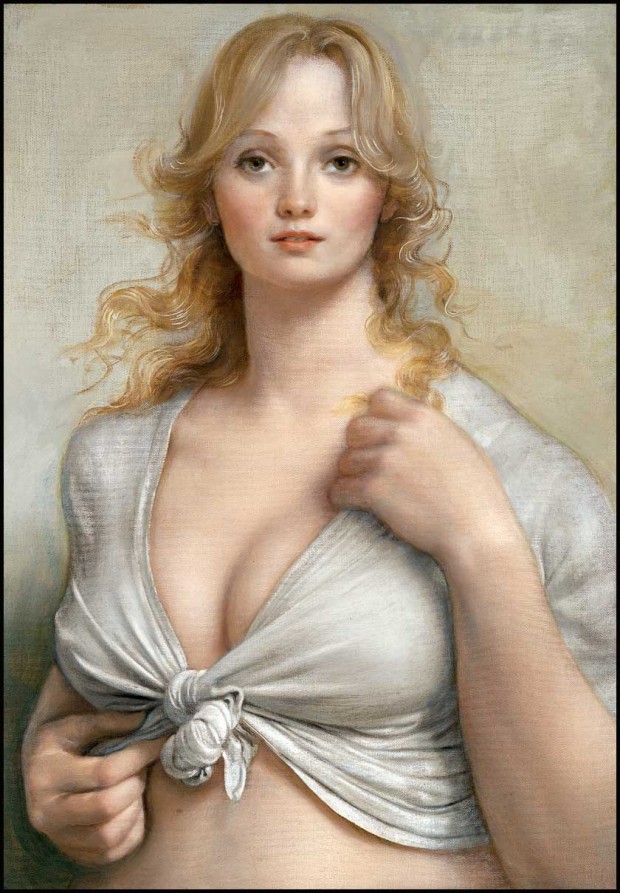An iconographic and text archive related to communication, technology and art.
☛ Tate Collection: “Honeymoon Nude” by John Currin, oil on canvas, 1168 x 914 x 33 mm, 1998. [Source of hi-res image].
‘What I do’, Currin has said, ‘is to find a cliché and try to believe in it’. His work rejects the decorous conventions of the female nude by melding art-historical references with the fantasies of advertising and pornography. The woman’s body and pose in Honeymoon Nude recall Renaissance prototypes (especially Botticelli’s Birth of Venus) but she has a recognizably contemporary face. Currin presents the female nude as a commodity, the embodiment of male fantasy. As if emphasizing the narcissistic aspects of desire, he bases the woman’s face on his own self-portrait. (read more about “Honeymoon Nude”)
Here’s a more recent painting by John Currin: “Big Hands”, oil on canvas, 101.6 x 71.1 cm, 2010 [information from artnet.com, source for hi-res image].
From The New York Times:
If you like creepy and sexy, John Currin’s paintings are for you. He pictures voluptuous but strangely proportioned women singly in erotic poses or making love with one or two other women. “Big Hands” is a bust-length portrait of a winsome blonde whose oddly small head is rendered with a feathery touch as if for one of those old Breck Shampoo ads. She has mannish hands and cantaloupe-size breasts wrapped in a white top knotted in front. “The Women of Franklin Street” represents a statuesque, brightly smiling “young lady” in erotic dishabille being caressed from front and back by two other women in a Rococo boudoir. With a lovingly painted, white porcelain tea service on a round black marble table in the foreground, it could be a scene from one of the Marquis de Sade’s milder narratives.
Exactly what Mr. Currin is up to is tantalizingly ambiguous. Do his paintings represent his own prurient fantasies, or is he satirizing “the male gaze”? And what about “Hot Pants,” the large painting of two stereotypically, pre-Stonewall, balding gay men, both in fancy suits with short shorts and knee socks, one a tailor fitting the other in his ridiculous outfit?
Mr. Currin’s painting style is similarly elusive. It resembles the work of a mid-20th-century anti-Modernist illustrator who has steeped himself in museum favorites from Velázquez to Renoir but never learned to draw properly. The way Mr. Currin hides genuine feeling behind coy facades is irritating, but his paintings remain fascinatingly bizarre. (“John Currin: ‘New Paintings’” by Ken Johnson, November18, 2010)
More resource online about John Currin:
- From The New Yorker:
- “The Elegant Scavenger. John Currin’s low comedy of high style” by Peter Schjeldahl, February 22, 1999.
- “Irresistible. John Currin at the Whitney” by Peter Schjeldahl, December 15, 2003
- “Lifting the Veil. Old Masters, pornography, and the work of John Currin” by Calvin Tomkins, January 38, 2008. A slide show complements Tomkins’ article.
- Slate: “Critics love the painter John Currin. But why?” by Mia Fineman, December 30, 2003. With accompanying slide show. Excerpt:
There are some wildly different ideas about exactly what Currin is up to—New York Times critic Michael Kimmelman sees him as “a latter-day Jeff Koons” trafficking in postmodern irony while Peter Schjeldahl at The New Yorker finds him a blissfully sincere artist tapping into the timeless values of “mystery, sublimity, transcendence.” But everyone is unanimous about one thing: John Currin can paint.
- The Gagosian Gallery put together two catalogs of John Currin paintings:
- John Currin, with essays by Norman Bryson, Alison M. Gingeras, Dave Eggers; edited by Kara Vander Weg with Rose Dergan, published by Rizzoli International Publications, 2006. A book preview is available for download (PDF).
- John Currin, texts by Wells Tower, interview between John Currin and Angus Cook, distributed by Rizzoli International Publications, Inc., in association with Gagosian Gallery, 2011.
- The contemporary art gallery Sadie Coles HQ produced an interesting press release for a John Currin exhibition held in 2008.
- Below is a photograph of John Currin by Annie Leibovitz. The photo illustrates an article published in this month edition of Vanity Fair: “V.F. Portrait: John Currin” by A. M. Homes, September 2011.

- By Philippe Theophanidis
- on
- ― Published in Art, Painting
- Tagged: body, John Currin, nude, portrait, representation, woman


